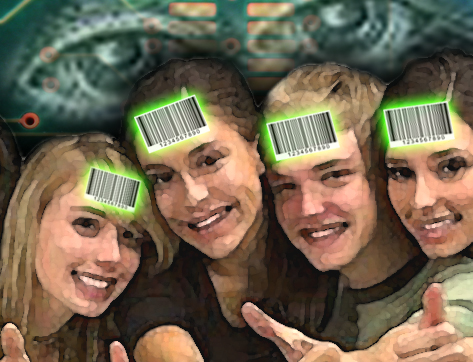
By Mark Anderson
Just outside of San Antonio, Texas, an honor student has stepped out of formation to protest the “Student Locator Project” just launched by the huge Northside Independent School District (NISD). The program would compel 4,200 pupils in John Jay High School and Anson Jones Middle School to wear radio frequency identification (RFID) microchips embedded in the student IDs worn around their necks.
With input from national RFID critic Dr. Katherine Albrecht—a noted author who has long challenged proposals to implant tiny RFID chips in state drivers licenses, under human skin and other applications—John Jay High student Andrea Hernandez has emerged as the most vocal among skeptical or undecided students in protesting the realities of RFID technology, involving tiny chips that emit a trackable signal, much like tagging livestock or pets.
While such chips can hold reams of personal data, the NISD’s plan is apparently limited to tracking students with the help of “electronic readers, which are installed throughout the campus,” an NISD letter informed parents. Each chip has a 70-foot range. In what functions like an indirect head tax, the NISD concedes that if tracking each student improves student attendance, the district gets more state revenue.
On the first day of school August 27, the NISD officially launched its mandate that all the students at those two schools must wear the tags, each of which emits a unique signal for a particular student. Miss Hernandez is refusing to wear her device based on her religious beliefs. Her father, Steven, was recently quoted on TV News 4 in San Antonio: “[This] is a school district and not a government, and they need to understand that.”
“Those tags don’t turn off when students leave school, and that makes parents wonder about predators,” a News 4 reporter added.
NISD says it will only track students during the school day on school grounds and will utilize this “Smart ID” for general needs like library and lunch admission and for extracurricular activities.
Liz McIntyre, who co-authored the book SPYCHiPS: How major corporations and government plan to track your every move with RFID with Ms. Albrecht, pointed out to AMERICAN FREE PRESS that students could abandon their tags or trade them. Therefore, a certain “chip” may register a particular student as “present” in the building, but the student IDed with that chip may have left the campus, or a chip may show a certain student is somewhere “on campus” but it could be worn by someone else, left in a locker or abandoned.
There are also concerns that someone off campus with a chip reader could follow a student after school hours because the chips never turn off, Ms. McIntyre confirmed.
NISD Communications Director Pascual Gonzalez said that the tag rule wouldn’t be fully implemented until about mid-October. Gonzalez was confident that dissent would be stopped.
“Once it’s fully implemented, she’ll follow the rules like anyone else,” he said of Miss Hernandez, speaking to AFP September 7, implying that the view of one must be subordinated to the alleged needs of the herd. “She [Miss Hernandez] is making a big deal out of it—one student out of 4,200.”
Concerned citizens, including Miss Hernandez’s father, came from all over Texas to the August 28 NISD school board meeting to protest the local use of these tracking badges and to address the board. However, “Board Talks,” a shortened online account of all board meetings, makes no mention of concerns being brought before the board about the Student Locator Project on August 28. The longer official board meeting minutes evidently are not posted online.
Gonzalez dismissed the protestors as out-of-towners—as if concerns from outside of the district, by definition, are automatically irrelevant.
“This is the pilot phase only for these two schools. It could be extended to one or more [additional] schools next year,” Gonzalez said, claiming that the tagging system is a “local initiative” born at NISD, not in Austin nor in D.C. When pressed, however, he said NISD copied the tagging plan from the large Spring Independent School District near Houston. NISD’s private vendor for the tags is Wade / Garcia & Associates of San Antonio.
According to Ms. McIntyre, the chipping industry seeks vulnerable subjects like those in poorer schools, such as John Jay and Anson, to “get their foot in the door” where single-parent families and other stressed households are too busy making ends meet to object. Texans outside NISD believe this concept is “heading their way” and are protesting the NISD plan in principle, Ms.McIntyre added.
In the NISD, which is the fourth largest district in Texas, there are 112 buildings and an estimated 100K students. Gonzalez inferred they’ll all be tagged eventually, meaning that a district with a population rivaling that of sizable U.S. cities would be wired for surveillance, like it or not.
For taking a stand, Miss Hernandez was almost refused entry into NISD, yet she still will not wear her badge. NISD already has installed digital cameras in all school buses and in every building except elementary school facilities. Some see this as a small price for safety, while others see it as a big leap for transforming schools into components of a police state.
Mark Anderson is AFP’s roving editor. Listen to Mark’s weekly radio show and email him at [email protected].

